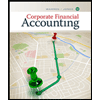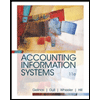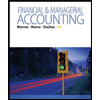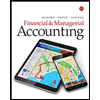
INTERMEDIATE ACTG+CONNECT <LOOSE>
9th Edition
ISBN: 9781260517125
Author: SPICELAND
Publisher: MCGRAW-HILL CUSTOM PUBLISHING
expand_more
expand_more
format_list_bulleted
Question
Chapter 20, Problem 20.3BYP
(1)
To determine
Accounting changes:
Accounting changes can be implemented as retrospectively (revision in prior period statements) or prospectively (change in current and future periods) or by modified retrospective approach (affect a new standard only to the implementation period).
Accounting change can be classified as:
- Changes in accounting principle.
- Changes in estimate.
- Changes in reporting entity.
To discuss: The actions considered towards softening the wrong issues.
(2)
To determine
To identify: The ethical dilemma and the likely impact of following up on thoughts of Person J and the persons who would be benefited and injured.
Expert Solution & Answer
Want to see the full answer?
Check out a sample textbook solution
Students have asked these similar questions
Please provide the answer to this general accounting question using the right approach.
I need assistance with this general accounting question using appropriate principles.
Can you solve this general accounting problem using appropriate accounting principles?
Chapter 20 Solutions
INTERMEDIATE ACTG+CONNECT <LOOSE>
Ch. 20 - Prob. 20.1QCh. 20 - There are three basic accounting approaches to...Ch. 20 - Prob. 20.3QCh. 20 - Lynch Corporation changes from the...Ch. 20 - Sugarbaker Designs Inc. changed from the FIFO...Ch. 20 - Most changes in accounting principles are recorded...Ch. 20 - Southeast Steel, Inc., changed from the FIFO...Ch. 20 - Prob. 20.8QCh. 20 - Its not easy sometimes to distinguish between a...Ch. 20 - For financial reporting, a reporting entity can be...
Ch. 20 - Prob. 20.11QCh. 20 - Describe the process of correcting an error when...Ch. 20 - Prob. 20.13QCh. 20 - If it is discovered that an extraordinary repair...Ch. 20 - Prob. 20.15QCh. 20 - Change in inventory methods; FIFO method to the...Ch. 20 - Change in inventory methods; average cost method...Ch. 20 - Change in inventory methods; FIFO method to the...Ch. 20 - Change in depreciation methods LO203 Irwin, Inc.,...Ch. 20 - Prob. 20.5BECh. 20 - Book royalties LO204 Three programmers at Feenix...Ch. 20 - Warranty expense LO204 In 2017, Quapau Products...Ch. 20 - Change in estimate; useful life of patent LO204...Ch. 20 - Prob. 20.9BECh. 20 - Error correction LO206 In 2018, internal auditors...Ch. 20 - Prob. 20.11BECh. 20 - Error correction LO206 In 2018, the internal...Ch. 20 - Change in principle; change in inventory methods ...Ch. 20 - Change in principle; change in inventory methods ...Ch. 20 - Change from the treasury stock method to retired...Ch. 20 - Change in principle; change to the equity method ...Ch. 20 - Prob. 20.5ECh. 20 - FASB codification research LO202 Access the FASB...Ch. 20 - Change in principle; change in inventory cost...Ch. 20 - Change in inventory methods; FIFO method to the...Ch. 20 - Change in inventory methods; FIFO method to the...Ch. 20 - Change in depreciation methods LO203 For...Ch. 20 - Change in depreciation methods LO203 The Canliss...Ch. 20 - Book royalties LO204 Dreighton Engineering Group...Ch. 20 - Loss contingency LO204 The Commonwealth of...Ch. 20 - Warranty expense LO204 Woodmier Lawn Products...Ch. 20 - Prob. 20.15ECh. 20 - Accounting change LO204 The Peridot Company...Ch. 20 - Change in estimate; useful life and residual value...Ch. 20 - Classifying accounting changes LO201 through...Ch. 20 - Error correction; inventory error LO206 During...Ch. 20 - Error corrections; investment LO206 Required: 1....Ch. 20 - Prob. 20.21ECh. 20 - Prob. 20.22ECh. 20 - Prob. 20.23ECh. 20 - Inventory errors LO206 Indicate with the...Ch. 20 - Classifying accounting changes and errors LO201...Ch. 20 - Change in inventory costing methods; comparative...Ch. 20 - P 20-2 Change in principle; change in method of...Ch. 20 - Change in inventory costing methods; comparative...Ch. 20 - Change in inventory methods LO202 The Rockwell...Ch. 20 - Change in inventory methods LO202 Fantasy...Ch. 20 - Change in principle; change in depreciation...Ch. 20 - Depletion; change in estimate LO204 In 2018, the...Ch. 20 - Accounting changes; six situations LO201, LO203,...Ch. 20 - Prob. 20.9PCh. 20 - Inventory errors LO206 You have been hired as the...Ch. 20 - Error correction; change in depreciation method ...Ch. 20 - Accounting changes and error correction; seven...Ch. 20 - Prob. 20.13PCh. 20 - Prob. 20.14PCh. 20 - Prob. 20.15PCh. 20 - Prob. 20.16PCh. 20 - Prob. 20.17PCh. 20 - Integrating Case 201 Change to dollar-value LIFO ...Ch. 20 - Prob. 20.2BYPCh. 20 - Prob. 20.3BYPCh. 20 - Analysis Case 204 Change in inventory methods;...Ch. 20 - Prob. 20.5BYPCh. 20 - Prob. 20.6BYPCh. 20 - Analysis Case 208 Various changes LO201 through...Ch. 20 - Analysis Case 209 Various changes LO201 through...Ch. 20 - Prob. 20.10BYPCh. 20 - Prob. 20.11BYPCh. 20 - Prob. 20.12BYPCh. 20 - Prob. 1CCTC
Knowledge Booster
Similar questions
- I need help solving this general accounting question with the proper methodology.arrow_forwardHenderson Corporation uses the calendar year as its tax year. It acquires and places into service two depreciable assets during 2024: • Asset #1: 7-year property; $940,000 cost; placed into service on January 20. Asset #2: 5-year property; $410,000 cost; placed into service on August 1. View the MACRS half-year convention rates. Read the requirements. Calculate Henderson's depreciation deductions for 2024. (Use MACRS rates to two decimal places, X.XX%. Round the MACRS depreciation to the nearest dollar.) 2024 Depreciation Asset #1 Asset #2 Total depreciation 134,326 82,000 216,326 Calculate Henderson's depreciation deductions for 2025. (Use MACRS rates to two decimal places, X.XX%. Round the MACRS depreciation to the nearest dollar.) 2025 Depreciation Asset #1 Asset #2 Total depreciation 230,206 131,200 361,406 b. What are Henderson's depreciation deductions for 2024 and 2025 if this is the only property it places into service in those years and Henderson elects Sec. 179 expensing for…arrow_forwardPlease explain the solution to this general accounting problem with accurate principles.arrow_forward
- Henderson Corporation uses the calendar year as its tax year. It acquires and places into service two depreciable assets during 2024: • Asset #1: 7-year property; $940,000 cost; placed into service on January 20. Asset #2: 5-year property; $410,000 cost; placed into service on August 1. View the MACRS half-year convention rates. Read the requirements. Calculate Henderson's depreciation deductions for 2024. (Use MACRS rates to two decimal places, X.XX%. Round the MACRS depreciation to the nearest dollar.) 2024 Depreciation Asset #1 Asset #2 Total depreciation 134,326 82,000 216,326 Calculate Henderson's depreciation deductions for 2025. (Use MACRS rates to two decimal places, X.XX%. Round the MACRS depreciation to the nearest dollar.) 2025 Depreciation Asset #1 Asset #2 Total depreciation 230,206 131,200 361,406 b. What are Henderson's depreciation deductions for 2024 and 2025 if this is the only property it places into service in those years and Henderson elects Sec. 179 expensing for…arrow_forwardCarlyon Company listed the following items in its December 31, Year 1, financial statements: Investment in Man Company bonds $21,000 Dividends payable: preferred 4,000 Dividends payable: common 50,000 Preferred stock, 8%, $100 par 100,000 Common stock, $10 par 500,000 Additional paid-in capital on preferred stock 20,000 Additional paid-in capital on common stock 262,500 Retained earnings 270,000 During Year 2, the following transactions occurred: Feb. 2 Paid the semiannual dividends declared on December 15, Year 1. Mar. 5 Declared a property dividend, payable to common shareholders on April 5 in Man Company bonds being held to maturity. The bonds (which have a book value of $21,000) have a current market value of $30,000. Apr. 5 Paid the property dividend. Jul. 6 Declared a $4 per share semiannual cash dividend on preferred stock and a $1.10 per share semiannual dividend on common stock, to be paid on August 17. Aug. 17 Paid the cash dividends.…arrow_forwardRequired information [The following information applies to the questions displayed below.] Jarvie loves to bike. In fact, he has always turned down better-paying jobs to work in bicycle shops where he gets an employee discount. At Jarvie's current shop, Bad Dog Cycles, each employee is allowed to purchase four bicycles a year at a discount. Bad Dog has an average gross profit percentage on bicycles of 25 percent. During the current year, Jarvie bought the following bikes: Description Retail Price Specialized road bike $ 4,000 Cost $ 3,600 Employee Price $ 2,800 Rocky Mountain mountain bike 5,000 4,100 4,000 Trek road bike 3,900 3,300 2,730 Yeti mountain bike 4,600 3,400 3,680 b. What amount of deductions is Bad Dog allowed to claim from these transactions? Amount of deductionsarrow_forward
- Jarvie loves to bike. In fact, he has always turned down better-paying jobs to work in bicycle shops where he gets an employee discount. At Jarvie's current shop, Bad Dog Cycles, each employee is allowed to purchase four bicycles a year at a discount. Bad Dog has an average gross profit percentage on bicycles of 25 percent. During the current year, Jarvie bought the following bikes: Description Retail Price Specialized road bike $ 4,000 Cost $ 3,600 Employee Price $ 2,800 Rocky Mountain mountain bike 5,000 4,100 4,000 Trek road bike 3,900 3,300 2,730 Yeti mountain bike 4,600 3,400 3,680 a. What amount is Jarvie required to include in taxable income from these purchases? Amount to be includedarrow_forwardYost received 300 NQOs (each option gives Yost the right to purchase 10 shares of Cutter Corporation stock for $19 per share). At the time he started working for Cutter Corporation three years ago, Cutter's stock price was $19 per share. Yost exercised all of his options when the share price was $38 per share. Two years after acquiring the shares, he sold them at $59 per share. Note: Input all amounts as positive values. Leave no answer blank. Enter zero if applicable. d. Assume that Yost's options were exercisable at $24 and expired after five years. If the stock only reached $22 during its high point during the five-year period, what are Yost's tax consequences on the grant date, the exercise date, and the date the shares are sold, assuming his ordinary marginal rate is 35 percent and his long-term capital gains rate is 15 percent? Grant date Exercise date Taxes Due Sale datearrow_forwardMark received 10 ISOs (each option gives him the right to purchase 14 shares of Hendricks Corporation stock for $6 per share) at the time he started working for Hendricks Corporation five years ago, when Hendricks's stock price was $5 per share. Now that Hendricks's share price is $35 per share, Mark intends to exercise all of his options and hold all of his shares for more than one year. Assume that more than a year after exercise, Mark sells the stock for $35 a share. Note: Enter all amounts as positive values. Leave no answers blank. Enter zero if applicable. b. What are Hendricks's tax consequences on the grant date, the exercise date, and the date Mark sells the shares? Grant date Exercise date Sale date Tax Benefitarrow_forward
- Yost received 300 NQOs (each option gives Yost the right to purchase 10 shares of Cutter Corporation stock for $19 per share). At the time he started working for Cutter Corporation three years ago, Cutter's stock price was $19 per share. Yost exercised all of his options when the share price was $38 per share. Two years after acquiring the shares, he sold them at $59 per share. Note: Input all amounts as positive values. Leave no answer blank. Enter zero if applicable. c. Assume that Yost is "cash poor" and needs to engage in a same-day sale in order to buy his shares. Due to his belief that the stock price is going to increase significantly, he wants to maintain as many shares as possible. How many shares must he sell in order to cover his purchase price and taxes payable on the exercise? Number of shares to be soldarrow_forwardMark received 10 ISOs (each option gives him the right to purchase 14 shares of Hendricks Corporation stock for $6 per share) at the time he started working for Hendricks Corporation five years ago, when Hendricks's stock price was $5 per share. Now that Hendricks's share price is $35 per share, Mark intends to exercise all of his options and hold all of his shares for more than one year. Assume that more than a year after exercise, Mark sells the stock for $35 a share. Note: Enter all amounts as positive values. Leave no answers blank. Enter zero if applicable. a. What are Mark's taxes due on the grant date, the exercise date, and the date he sells the shares, assuming his ordinary marginal rate is 32 percent and his long-term capital gains rate is 15 percent? Grant date Exercise date Sale date Taxes Duearrow_forwardOn January 1, year 1, Dave received 2,500 shares of restricted stock from his employer, RRK Corporation. On that date, the stock price was $13 per share. On receiving the restricted stock, Dave made the 83(b) election. Dave's restricted shares will vest at the end of year 2. He intends to hold the shares until the end of year 4, when he intends to sell them to help fund the purchase of a new home. Dave predicts the share price of RRK will be $33 per share when his shares vest and $54 per share when he sells them. Assume that Dave's price predictions are correct, and answer the following questions: Note: Leave no answers blank. Enter zero if applicable. Round your final answer to the nearest whole dollar value. Enter all amounts as positive values. b. What are the tax consequences of these transactions to RRK? Grant date Tax consequences Vesting date $ 0 Sale date $ 0arrow_forward
arrow_back_ios
SEE MORE QUESTIONS
arrow_forward_ios
Recommended textbooks for you
 AccountingAccountingISBN:9781337272094Author:WARREN, Carl S., Reeve, James M., Duchac, Jonathan E.Publisher:Cengage Learning,
AccountingAccountingISBN:9781337272094Author:WARREN, Carl S., Reeve, James M., Duchac, Jonathan E.Publisher:Cengage Learning, Corporate Financial AccountingAccountingISBN:9781337398169Author:Carl Warren, Jeff JonesPublisher:Cengage Learning
Corporate Financial AccountingAccountingISBN:9781337398169Author:Carl Warren, Jeff JonesPublisher:Cengage Learning Accounting Information SystemsFinanceISBN:9781337552127Author:Ulric J. Gelinas, Richard B. Dull, Patrick Wheeler, Mary Callahan HillPublisher:Cengage Learning
Accounting Information SystemsFinanceISBN:9781337552127Author:Ulric J. Gelinas, Richard B. Dull, Patrick Wheeler, Mary Callahan HillPublisher:Cengage Learning Financial & Managerial AccountingAccountingISBN:9781285866307Author:Carl Warren, James M. Reeve, Jonathan DuchacPublisher:Cengage Learning
Financial & Managerial AccountingAccountingISBN:9781285866307Author:Carl Warren, James M. Reeve, Jonathan DuchacPublisher:Cengage Learning Accounting (Text Only)AccountingISBN:9781285743615Author:Carl Warren, James M. Reeve, Jonathan DuchacPublisher:Cengage Learning
Accounting (Text Only)AccountingISBN:9781285743615Author:Carl Warren, James M. Reeve, Jonathan DuchacPublisher:Cengage Learning Financial & Managerial AccountingAccountingISBN:9781337119207Author:Carl Warren, James M. Reeve, Jonathan DuchacPublisher:Cengage Learning
Financial & Managerial AccountingAccountingISBN:9781337119207Author:Carl Warren, James M. Reeve, Jonathan DuchacPublisher:Cengage Learning

Accounting
Accounting
ISBN:9781337272094
Author:WARREN, Carl S., Reeve, James M., Duchac, Jonathan E.
Publisher:Cengage Learning,

Corporate Financial Accounting
Accounting
ISBN:9781337398169
Author:Carl Warren, Jeff Jones
Publisher:Cengage Learning

Accounting Information Systems
Finance
ISBN:9781337552127
Author:Ulric J. Gelinas, Richard B. Dull, Patrick Wheeler, Mary Callahan Hill
Publisher:Cengage Learning

Financial & Managerial Accounting
Accounting
ISBN:9781285866307
Author:Carl Warren, James M. Reeve, Jonathan Duchac
Publisher:Cengage Learning

Accounting (Text Only)
Accounting
ISBN:9781285743615
Author:Carl Warren, James M. Reeve, Jonathan Duchac
Publisher:Cengage Learning

Financial & Managerial Accounting
Accounting
ISBN:9781337119207
Author:Carl Warren, James M. Reeve, Jonathan Duchac
Publisher:Cengage Learning